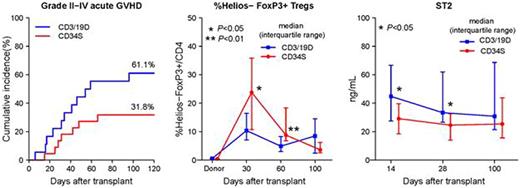Abstract
INTRODUCTION:
Ex-vivo T cell depletion strategies have been widely used to reduce the incidence of graft versus host disease (GVHD) in allogeneic stem cell transplantation (allo-SCT). Although several options of ex-vivo graft manipulation strategy are available, direct comparison between strategies along with relevant biomarkers has been lacking. Here we evaluated cellular and plasma biomarkers in two separate graft manipulation strategies, CD3-CD19 depletion versus CD34+ selection using the Miltenyi CliniMACS and their association with clinical outcomes.
METHODS:
Forty two subjects with hematological malignancies underwent HLA matched sibling allo-SCT at a single center between 2012 and 2015 and received either an ex-vivo CD3-CD19 depleted, CD34+ negatively selected graft (CD3/19D, n=20) or an ex-vivo CD34+ cell positively selected graft (CD34S, n=22). Both cohorts were treated with the same conditioning regimen of cyclophosphamide, fludarabine, and total body irradiation (600-1200 cGy) and GVHD prophylaxis of low dose cyclosporine. Peripheral blood mononuclear cells and plasma samples were collected at days 14 or 30, 60, 100 post-transplant. Post-transplant cellular immune reconstitution was evaluated by multi-color flow cytometry immunophenotyping, characterizing the subsets of memory T cells, regulatory T cells (Tregs), natural killer (NK) cells, and B cells with various functional markers. The plasma levels of ST2, Reg3α, and sTNFR1 were measured using enzyme-linked immunosorbent assay (ELISA).
RESULTS:
The median age at transplant was 48 years (range 17-70) in CD3/19D and 45 years (11-73) in CD34S. At a median follow up of 37 months in CD3/19D and 22 months in CD34S, the major clinical outcomes were similar between two groups; the overall survival (70% and 86%), non-relapse mortality (5% and 4.5%), and cumulative incidence of relapse (35% and 39%) at 2 years, respectively. Two subjects in CD3/19D developed late engraftment failure before day 100 but all other subjects achieved primary neutrophil and platelet recovery. Unexpectedly, the cumulative incidence of grade II-IV acute GVHD was higher in CD3/19D (61%) in comparison to the incidence in CD34S (32%, P=0.07, Figure). The cumulative incidence of extensive chronic GVHD was 33% in CD3/19S and 24% in CD34S. The fraction of Helios negative Tregs post-transplant was significantly lower in CD3/19D (median [interquartile range]: 10.4% [7.1-16.4] at day 30; 4.9% [3.0-8.3] at day 60) compared to CD34S (23.8% [10.7-35.8], P=0.03 at day 30; 8.8% [6.8-18.4], P=0.01 at day 60, Figure). Plasma ST2 levels were significantly higher in CD3/19D (45ng/mL [27-67] at day 14; 33ng/mL [27-62] at day 28) in comparison to CD34S (29ng/mL [19-40], P=0.03 at day 14; 25ng/mL [14-33], P=0.03 at day 28, Figure). In addition, significantly higher CD4 naive T cells, lower effector memory and PD-1 bright CD4 T cells were observed in CD3/19D in comparison to CD34S. NK and B cell profiles were not significantly different between the two groups.
CONCLUSION:
Both methods of ex vivo TCD were associated with extremely low NRM rates (~5%).We observed a higher cumulative incidence of acute GVHD in the recipients of CD3/19 depleted grafts, accompanied with the distinct biomarker profiles of poor Treg reconstitution and high level of ST2. CD3/19 depletion may have disproportionately depleted Tregs in the graft, leading to uncontrolled tissue damage and GVHD evidenced by higher ST2 levels. Further validation is required to confirm the utility of monitoring Treg reconstitution and ST2 level as biomarkers to predict the outcomes of T cell depleted allo-SCT.
Battiwalla:NIH/NHLBI: Employment.
Author notes
Asterisk with author names denotes non-ASH members.


This feature is available to Subscribers Only
Sign In or Create an Account Close Modal